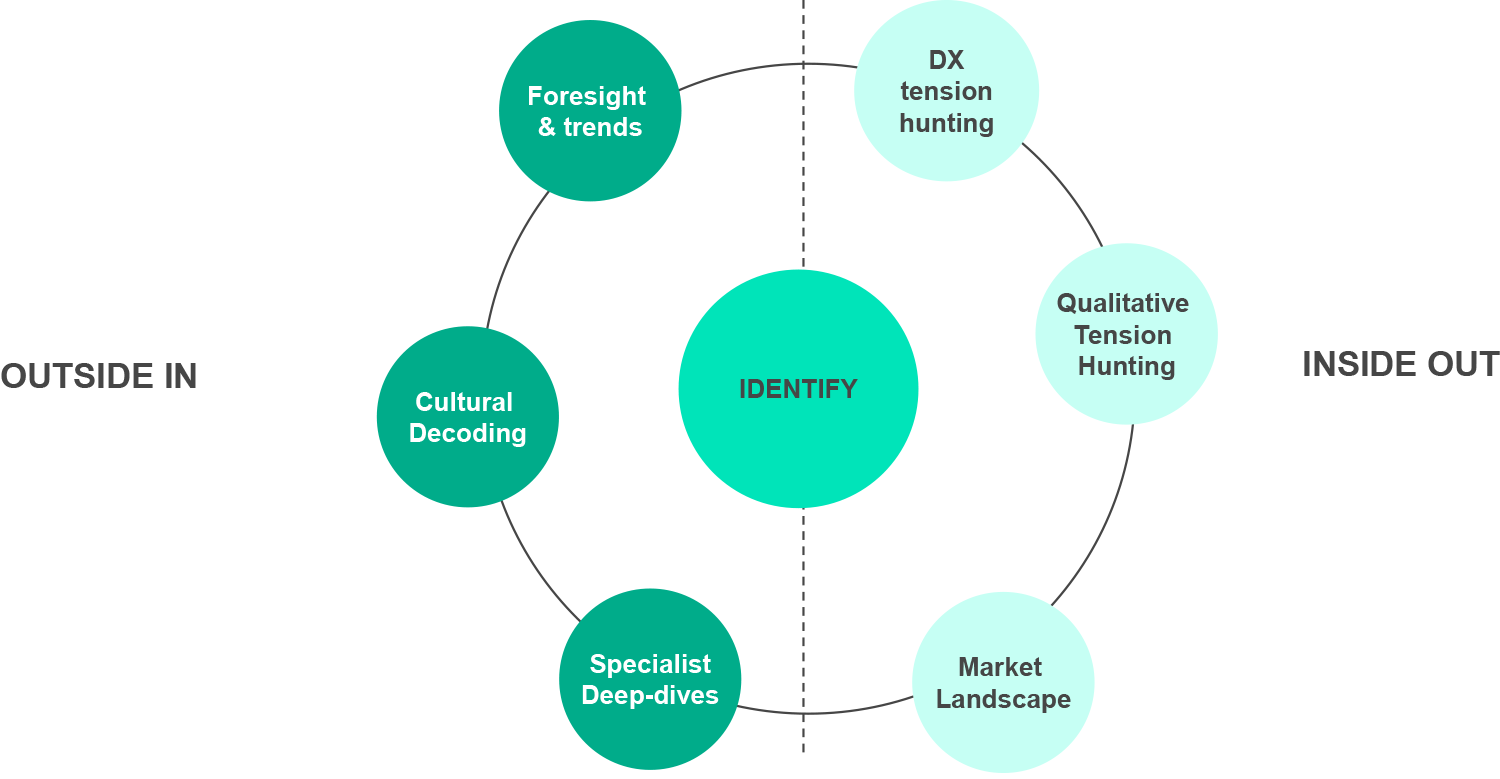In an era of disruption, innovation remains the key to brand growth. But volatile times need a new approach to innovation. One that is built from robust foundations and centered around a deep understanding of people – and one that helps innovators zero in on the right opportunities amid the chaos of constant change, endless data and infinite choices.
How do you find the right opportunities for innovation?
Behind every great innovation, no matter how big or small, is someone who spotted a great opportunity. But that doesn’t mean that all innovation originates from a flash of lone inspiration - it just makes for a good story when it does.
What truly unites every inspiring innovator, be it Nike, Net-A-Porter or Nest, is their ability to connect the dots between what is now, what’s to come and what’s happening around them. The ability to see an opportunity where others don’t is at the intersection of these three lenses.
Endless ideation is not the answer
This is not to say a spark of creativity is not needed to inspire a great innovation. On the contrary, imagination is a critical pillar of how we craft ideas that capture hearts and minds. But that spark rarely emerges solely from endless, aimless brainstorming, which all too often produces a plethora of ideas, but few truly successful innovations.
Instead, meaningful innovation is first and foremost about finding the right areas of focus. At Kantar, we use systems thinking to create that focus. We explore a problem or situation through different lenses to uncover more holistic and powerful innovation opportunities. We look through multiple lenses of insight, from the familiar to the far-out, to explore what the future might bring.
White space can get crowded
So where do we start? As innovators we are often encouraged to spend our time looking for the white space in a product category - where existing tensions go unmet and unarticulated. The problem is that these opportunities, rooted in today’s behaviours, are usually relatively easy to discover. And if you can see them, so can your competition. An innovation designed to take advantage of a current white space may well be meaningful but may not be unique enough to stand out from the crowd.
Look for blind spots, not just white space
In contrast to white spaces, blind spots are found at the periphery. They are the emerging tensions, workarounds, and aspirations that will become widespread pain points if left unresolved. As such, they offer even greater growth potential than today’s more easily recognised white spaces, because if the problem is likely to scale, so is the solution to that problem.
Difficult to identify using traditional research techniques, these fledgling behaviours offer the potential for meaningful and different innovation. To implement a successful innovation strategy, brand innovators must get comfortable experimenting with new tools and types of learning to bring opportunities for innovation into sharper focus, and hone their skills in filtering, synthesising and unlocking connections with the insights they identify.
Look beyond today
Most importantly, great innovators share an ability to look beyond today. To see what could be, not just what is. Without that ability to explore future possibilities, innovation gets locked into the context defined by today’s behaviours, today’s product category and today’s culture. Meaningful innovation requires an open mindset that takes those givens and extrapolates to envisage something better. Take the classic example of the Nintendo Wii, designed from the start to re-envisage game play in a way that would appeal to a broad cross-section of people, and not compete head-to-head for the gamer audience with Sony and Microsoft. Launched at a time of growing interest in wellbeing and health as a lifestyle, demand for the Wii exceeded supply and over 100 million units were sold in the first year.
Strategic innovation examples
With a rising cultural interest in wellness against a backdrop of growing global health concerns, innovators across markets recognised the healthcare experience had not caught up with broader consumer expectations. Projecting that discontent with long waits to see a doctor was only likely to grow, new services that combined the best of consumer experience in tech with the tensions of the healthcare system were launched. From Teladoc in the US to the NHS’ Livi app in the UK, new health-tech innovations allow people to book a video call with a doctor quickly and efficiently - which became more important than ever for people of all ages when the pandemic struck. The Livi app is now used by over 6 million people in the UK, while Teladoc has 51.5m paying members.
So how do you identify meaningful innovation opportunities?
The key to innovation success is to systematically explore multiple angles and insight sources to identify the most likely developments within a specific context: what is, what’s to come and what’s happening around you.
At Kantar, we developed a new approach with two key mindsets that help us take clients on a journey of possibilities before synthesising the richest opportunities to activate. We call this Inside Out and Outside In thinking.
Anticipate innovation white spaces that drive real growth

Inside Out thinking explores the world as it is today, taking account of your brand’s current power and potential, then envisages something better. From deep category and consumer understanding to tension hunting via social analytics, this is the sort of thinking that, leveraged alone, leads to effective product evolution - for example, the different generations of Gillette’s razors. But when combined with Outside In thinking, it forms a rich foundation of empathy and understanding that anchors future possibilities in a credible and ownable space for your brand.
Outside In thinking introduces a more radical way to re-envisage what’s to come and re-engage with what’s happening around you. It seeks to expand the frame of reference to take a wider view, exploring how people’s lives and attitudes are changing. It references how other categories have been re-imagined and seeks to serve new creative opportunities inspired by future and cultural trends. Lean into Outside In thinking too heavily, and you risk wasting time and resource on blue sky ideas that will never find a strategic fit with your brand’s ambitions. Combine it with Inside Out thinking and it will stretch your thinking and illuminate new possibilities that would otherwise remain unexplored.
While it is rare to find all these tools under one roof, at Kantar we believe it is this combination of insight sources, and the flexibility of mindsets to analyse them systematically and holistically, that powers us to unlock new growth opportunities for our clients.
How to future-proof your innovation
So, to future-proof your innovation strategy, it is critical to step outside the boundaries of what exists now and anticipate what the future might bring with an Outside In perspective. And, if you are innovating on behalf of an existing brand, you need to make sure there is a good fit with what your brand is known for – staying grounded with an Inside Out lens. Once you have a strong start with the right opportunity, you can accelerate the build and launch phases to nurture and develop great ideas.
Our next article in this innovation series will explore how to build and nurture the most powerful ideas to drive meaningful innovation. Catch up on the first two articles, looking at why innovation is important for brand growth, and how behavioral science can – and should – be used to help deliver successful innovation. If you haven’t yet, subscribe to our newsletter so you don’t miss the next article and get in touch to discuss how to uncover your brand’s next big opportunity.






